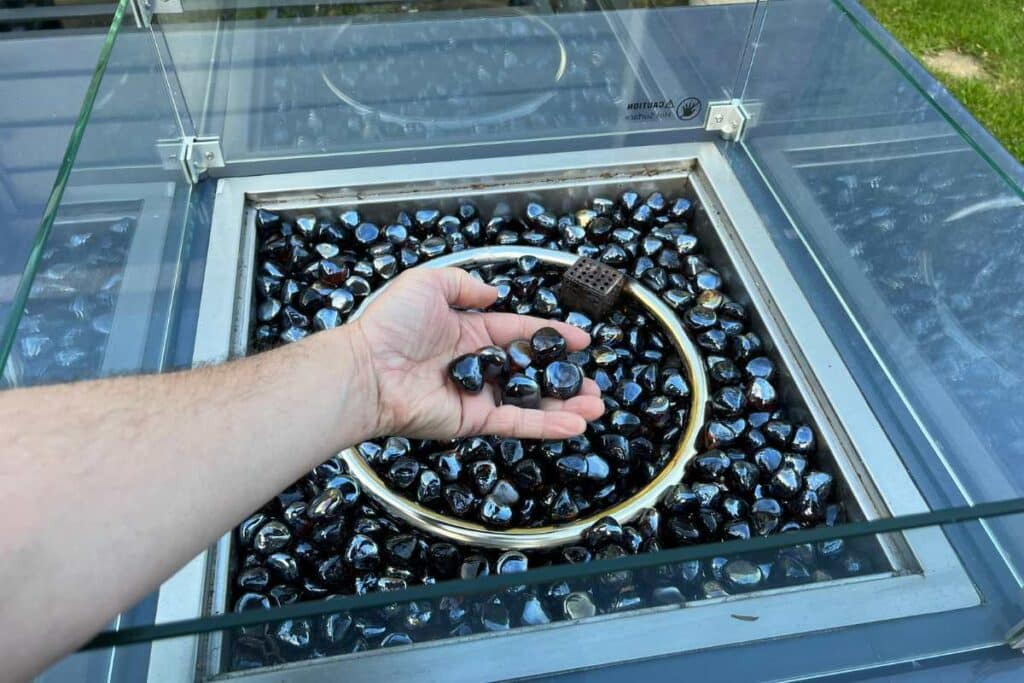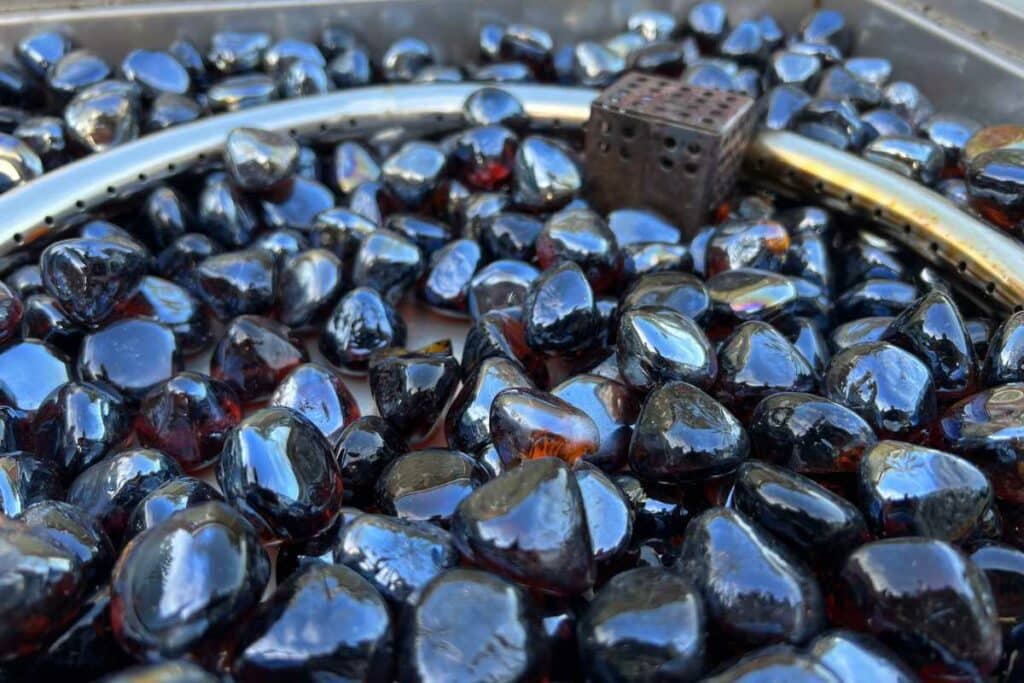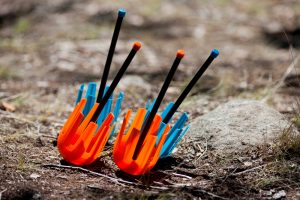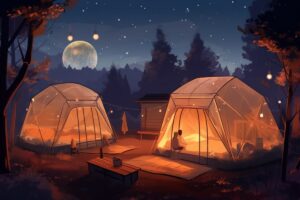Picture this: a beautiful summer evening, friends and family gathered around a mesmerizing fire pit, sharing stories and roasting marshmallows. Ah, the perfect setting for unforgettable memories.
But hold on, before you go blazing ahead with your fire pit installation, there are some common mistakes you want to avoid: From poor placement to safety slip-ups.
Get ready to learn some of the most common Fire Pit Mistakes and learn how to avoid them.
1. Poor Placement & Sizing
Placing your fire pit in the right location is crucial. One common mistake is placing the fire pit too close to flammable items and structures like your house, patio covers, trees, shrubs, or overhanging branches.
My issue is that it’s too close to a large tree. But, I have no other options. Every couple of days I have to pull out leaves and debris.

Keep a safe distance to prevent any fire accidents. For wood-fired pits, place them in an open area with no flammable objects nearby and with ample airflow.
Additionally, the size of your fire pit should match the existing space. You don’t want it to be too small or too large. If you’re uncertain about having a permanent fire pit or have limited space, a portable above-ground or gas fire table can offer flexibility and meet your space requirements.
When determining the size of your fire pit, consider accessibility and seating so that everyone can gather comfortably around it.
Avoid placing the fire feature on sloping grounds. Aim for a flat and level surface for maximum stability and safety.
If you are to install the fire pit on wooden decks, composite, vinyl, flagstone, or paver flooring, it’s crucial to add a fire pit heat deflector. This helps protect the floor materials from the intense heat by directing them away from the surface and towards the seating area.
Design Considerations
When constructing a fire pit, it’s crucial to consider both the height and circumference of the finished structure. Building a structure that is excessively high would be an unfortunate mistake.
For optimal functionality, the outer edge of the fire pit to be approximately 10 inches tall. This height offers a suitable barrier, effectively preventing logs from rolling out and ensuring that you can roast your marshmallows without having to lean in.
Additionally, the placement of the fire pit on your property holds great significance. Windy conditions can significantly impact your experience, especially when it comes to smoke. To minimize the inconvenience of smoke blowing directly on people’s faces, pay attention to the prevailing wind direction.
In areas prone to high winds, a skilled professional can assist in selecting an appropriate location for the fire pit. Alternatively, installing windscreens can be an effective solution to mitigate the adverse effects of wind.
2. Poor Material selection
When constructing your fire pit, do it with heat-resistant stones that can withstand high temperatures. Opt for materials like granite, limestone, masonry blocks, or concrete. Using the wrong stones can result in crumbling and breakage when exposed to heat.
The inner walls of your fire pit should be made of fireproof materials, such as fire bricks fireproof mortar, or grouting. These materials can withstand intense heat and maintain the structural integrity of the fire pit.
To protect your deck or surface from heat and potential damage, consider using a fire pit pad or barrier. Options like stone or metal can provide an additional layer of insulation and prevent direct contact between the fire pit and the surface.

3. Inadequate ventilation
All fuel sources require adequate airflow for proper combustion. Inadequate combustion leads to heavy smoke production and creosote and soot buildup.
Place your fire pit in a flat, open space without obstructing the airflow. The air vents should be clear and clean to allow air to mix in with the fuel whether it is wood, natural gas, or propane.
Include a properly sized air mixer orifice to ensure proper ventilation for gas-fired features. For wood fire pits, it is best to stick with smokeless fire pits.
4. Improper wood selection
Several kinds of woods can be used on a fire pit such as oak, hickory, and maple, among others. If available stick to hardwoods as they burn hotter, sustain the fire for longer, and produce minimal smoke.
Do not use green/fresh or unseasoned wood as it will cause heavy smoke, soot, and creosote buildup due to the higher moisture content in the wood. Be sure your firewood has had 6 to 24 months to dry out. Seasoned logs will look dry, are lighter, and have cracked ends.
Another mistake with firewood has to do with how it is stored. Avoid keeping the wood uncovered as the weather can be unforgiving.
Other materials to avoid burning in your fire pit include plastics, weeds, treated wood, stained wood, painted wood, decking wood, cardboard, or shipping pallets. These items may contain chemicals, adhesives, and resins that release toxic gases into the air or may burn uncontrollably.
5. Using lighter fluid/Gasoline
You will want to get your fire started as quickly as possible. But this should be done using a starting wood or dry tinder material such as a bit of newspaper and a kindling wood such as pine. Gasoline, kerosene, lighter fluid, or other flammable liquid is not the way to do it.
You may also like ?
-
10 Best Vegetables To Grow In The Winter
-
How To Heat Greenhouse In Winter (6 Proven Methods)
-
Lavender In Winter Guide (What To Expect)
-
Guide To Desert Plants: Types, Adaptations, And Landscaping Tips
-
Philodendron Care, Varieties, And Aesthetic Home Arrangements
-
Potato Bugs: Identification, Impact, And Control
6. Poor Gas line selection for your fire pit
When using a natural gas fire pit, you will want to select the proper gas line to get the gas to the fire feature. It should be a top-notch, whistle-free gas line.
A whistle-free line may cost more but is worth it in the end. These flex lines are specially designed to deal with whistling woes.
During installation, ensure the flex lines do not have any kinks or bends that can bottleneck the smooth flow of gas causing vibrations and annoying whistling noises. Keep the lines as smooth as possible and use smooth curves when it comes to changing direction.
All in all, it is best to stick to the services of a certified technician with any gas fire pit installation, especially if you are new to the game.
7. Too High a Gas pressure
Sticking to gas fire pits, our next point of contention is gas pressure that is too high. When the gas pressure is too cranked up, you will hear unpleasant whistling noises. Nobody wants this while trying to have a nice time.
You will need a trusty regulator to rein in the gas pressure before it reaches the burner. Call in a pro for proper installation and sizing of the regulator. Natural gas fire pit installations require some serious skill to get a handle on the calculations.
8. Poor fire pit Maintenance
To keep your fire feature in top shape, you have to maintain and clean it. If your fire pit is all caked up with soot and ash buildup, it will not be as appealing to look at or use.
This might not be as exciting but it is downright essential to keep your fire pit in proper working order. Trust me, this is worth the effort.
9. Safety Pitfalls of fire pits
Never leave a fire pit unattended, even for a short period. This can pose significant risks and is also illegal. Always extinguish the fire completely before leaving the area. Ensure someone is present to monitor the fire and extinguish it completely before going inside.
Also pay attention to the weather conditions, especially if your area experiences high winds. Avoid using the fire pit if it is too windy as this can increase fire risks.
Remember, fire can be unpredictable and destructive. Keep water, a shovel, sand, a fire extinguisher, fire blankets, and heat-resistant gloves handy to extinguish any fires in case of an emergency.
To Sum Up?
To fully enjoy your fire pit and create many memorable experiences, it’s important to avoid the mentioned mistakes. Prioritize safety and responsible fire management.
Building a fire pit involves following essential design principles while tailoring it to complement your backyard space.
If you find that designing an upscale fire pit space is more intricate than you anticipated, don’t hesitate to seek the expertise of fire pit designers and installers. They have deep knowledge and skills to bring your outdoor vision to life.
By taking these measures into account and relying on expert guidance when needed, you can create a safe and stunning fire pit space that enhances your outdoor living area and provides countless memorable moments.






